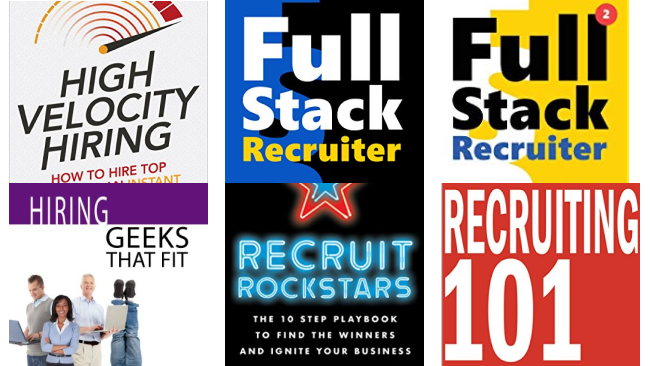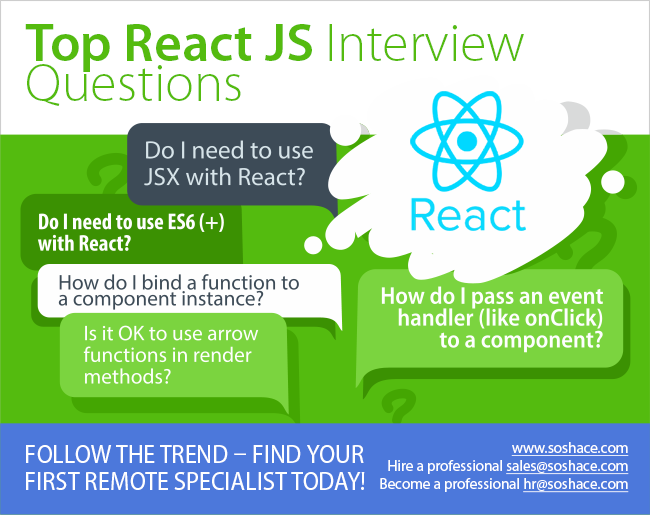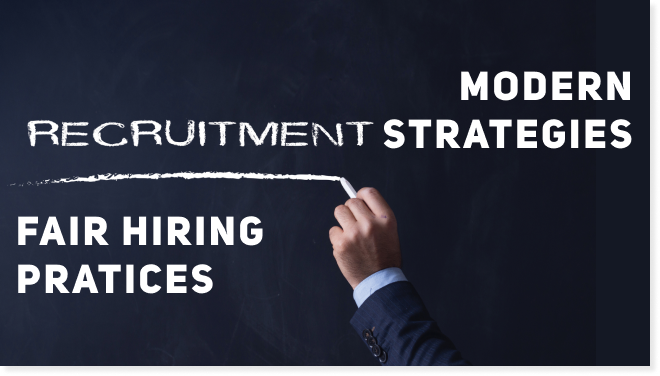
If you’re here, we’re bold enough to assume you might be concerned with improving the hiring process in your workplace. Perhaps, you’re stuck with unsuccessful past choices, would like to tackle new hiring challenges, or just want to get inspired by other people’s practices and cases. Whatever the reasons, you’re in the right place because we’ll cover the latest new books we’ve found either encouraging or simply super helpful and up to date.
Contents:
High Velocity Hiring: How to Hire Top Talent in an Instant (2017) | Scott Wintrip
Full Stack Recruiter (2017 and Full Stack: Recruiter New Secrets 2018) | Jan Tegze
Hiring Geeks That Fit (2014) | Johanna Rothman
Recruit Rockstars (2017) | Jeff Hyman
Recruiting 101: The Fundamentals of Being a Great Recruiter (2016) | Steven Mostyn
We haven’t included the big players, like Geoff Smart and Randy Street’s Who: The A Method of Hiring, because first of all, it was published back in 2008 and secondly, everyone seemed to have read the book by now. Instead, we’ve picked up the freshest publications the market has to offer, with relatively new crispy advice for those who hire professionals in a fast-paced tech world. We’ll start with a broader book (High Velocity Hiring) that many of you would love, even if you’re not hiring per se, but would like to know more about the process. Then we’ll cover more specific texts, like sourcing and hiring technical professionals, and wrap it all up with some basic literature if you’re a complete noob.
High Velocity Hiring: How to Hire Top Talent in an Instant (2017) | Scott Wintrip
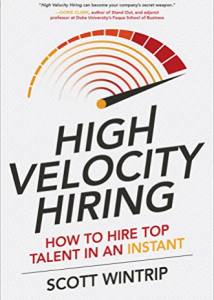
Scott Wintrip is an influential recruiting and hiring expert who had been on the Staffing Industry’s list of 100 most influential staffing leaders for five consecutive years; he’s also the founder of his own consulting group, Wintrip Consulting, and a renowned speaker of major recruiting conferences. His credentials are enough to assume that the author has definitely something valuable to share with his readers.
In his new book, Scott Wintrip introduces a few new concepts that he summarised under a broad idea of High Velocity Hiring, which basically substitutes the old reactive mindset of “keeping a job open until the right person shows up” with a more proactive approach of “cultivating top talent” first and then “waiting for the right job to open.”
To achieve the principals of on-demand hiring, Wintrip proposes the Talent Accelerator Process (TAP), a set of corporate policies that creates a pool of ready-to-hire prospective candidates with the right qualifications.
Wintrip argues that interviewing should be an ongoing process that only occasionally results in hiring the right person. Creating a Talent Inventory, a stockpile of people ready to hire, has numerous advantages, from shortening the time to search for the right candidate at the right time to keeping the overall hiring process smooth and flexible.
Overall we loved the book: it had valuable insights, covered all the steps and aspects of the proposed theory in detail, as well as included multiple cases from recent corporate history. However, as one of the reviewers on Amazon noticed, while the idea of Talent Inventory seems plausible and implementable, it might be difficult to achieve and maintain in the real world: you won’t necessarily have a pool of candidates waiting for your call for months on end, especially in a highly competitive market. But it’s a nice idea and certainly an engaging read.
Full Stack Recruiter (2017 and Full Stack: Recruiter New Secrets 2018) | Jan Tegze

Jan Tegze, the author of Full Stack Recruiter, promotes a proactive innovative approach to sourcing and marketing; he’s a professional blogger and an established Talent Acquisition Leader. His book, Full Stack Recruiter, is a gem of a book for a sourcer and anyone interested in perfecting and honing their recruiting skills. This is an informative and detailed guidebook on numerous sourcing techniques, from hacking Google and GitHub to developing a marketing mentality and using game theory and gamification techniques. In this article, we’ll cover two editions of the book, the original, published in 2017 and the new secrets from 2018 that came out after GDPR legislation and Cambridge Analytica scandal.
Tegze starts from a very beautiful premise of describing recruitment procedures from as far back as Julius Cesar and finishes the introduction with an eloquent piece of predicting what the HR world future might hold, which reads as though it’s an excerpt from science fiction. In the next chapters, he discusses the differences between sourcers, recruiters, and headhunters, with sorcerers culminating the domain as “artists.” The “art form” thing truly captured our attention and we are confident it will capture yours as well.
The sourcing chapters begin with an introduction to the art of google search, from the overview of boolean search operators to advanced search techniques, which would get you practically anywhere within the world wide web, a fantastic pool of hidden resume databases. If you’re a techie type, you’ll love those google hacking chapters, since they are prolific in detailed images, screenshots, examples of effective and complex search strings, and whatnot.
The sourcing chapters then delve in looking for candidates on Linkedin, Facebook, Twitter, Github, and other social media and specific communities. Tegze explains in great detail the searching for contributors on Github and Stack OverFlow, so if you seldom need to source for web developers and other technical bunch, then you’ll find an ample number of great stuff in those chapters.
Tegze has written several chapters on personal branding and employee value proposition for attracting industry top performance, as well as the importance of brand ambassadors and employee advocacy. So if you’re not familiar with those concepts, Tegze offers an informative read.
The last edition of Full Stack that came out in October 2018 deals with some of the changes that happened since the last publication of the book and offers some new tips and insights into popular concepts, like growth hacking or the importance of storytelling. The changes Tegze addresses primarily concern GDPR legislation and Cambridge Analytica scandal (an incident that exposed Facebook’s violation of users’ personal data protection rights) which both had a major effect on privacy laws and regulations. The aforesaid controversial events have definitely changed some of the sourcing approaches and steered the world of recruiting into a more conscious domain. Pages like fb.com/directory, WHOIS, or google.com/ncr have disappeared, Google + is shutting down after private user information became known to be exposed. A couple of new chapters were added for sourcing on Airbnb, Flickr, Medium, and WordPress.
Hiring Geeks That Fit (2014) | Johanna Rothman

Johanna Rothman is an extraordinary person in that she manages to consult, speak, and write on high-technology product development and her articles appeared in major publications, such as Computerworld, Cutter IT Journal, and others. Her bestselling book Hiring Geeks That Fit was born out of her Hiring Technical People blog where she had been sharing her consulting and hiring knowledge for a number of years.
In her book, Rothman argues that hiring technical people is not easy, because hiring managers must assess the tech’s ability to use their technical skills to benefit the product and assess their ability to adapt within the organization. The book consists of four parts, each dealing with a particular section or round of a hiring process: managing hiring time, sourcing the right candidates, preparing the interview questions and techniques, and bringing in the candidates to the workplace. The last sections of the book contain valuable resources like templates and checklists to track your own hiring process.
In part on managing the hiring time, Rothman goes into great detail about the importance of planning in the hiring process, she outlines every step of the way with approximate hours that need to be spent on each.
To avoid hiring mistakes, she suggests “hiring for attitude” or for “cultural fit”. She argues that irrespectively of how technically great a person is if he’s not a cultural fit, he will not stick with the organization. Rather than looking for “laundry lists” of technical skills that an applicant must possess, define a hiring strategy and identify the problems your company needs to address and solve.
Other valuable advice from the author:
— Create a super specific job description (never use generic templates, unless you want to find a generic person);
— Track your recruiting strategy and review your data on a weekly basis with numbers of checked resumes, phone screens, personal interviews, etc.;
— Source candidates through Linkedin, Twitter, other social networks; participate in job fairs or conferences; ask for referrals; become active on professional websites; affiliate with universities;
— Write different types of ads highlighting the main attractor that your company can offer (flyers, email, newsgroup ads, job boards, company’s website, radio and TV ads if budget allows);
— Develop interview questions and techniques (from closed and open questions to behavior-description, where you do not talk and do not lead a candidate to an answer, avoid hypothetical questions, riddles, puzzles, instead schedule auditions where a candidate solves a specific job-related problem.
For example, for a web developer, Rothman suggests the following audition approaches:
- Debugging (where you show a candidate a software in development and ask him to look for errors in the code thus, checking how he looks and identifies the problem, chooses and implements a solution)
- Product design (ask a candidate to redesign a product and explain why he chose a particular approach)
- Product review (present a candidate with a product and ask him to highlight questions or issues he has problems with or questions about)
- Programming and web development (ask the candidate to write code)
— Arrange interviews with team members and allocate questions (who’s going to ask what);
— Bring in the candidate: speed through the process so the candidate is still available for your job;
— Make the first day a great day: prepare the candidate for a smooth transition
Hiring Geeks That Fit provides an ample amount of great advice, interview questions, and templates specifically for hiring technical professionals, that’s exactly why we loved the book and recommend it to anyone interested in standardizing their procedures of working with the candidates, organizing the hiring process and introducing new employees to a faced paced technical teams.
Recruit Rockstars (2017) | Jeff Hyman
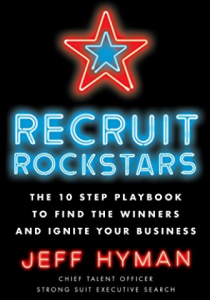
Jeff Hyman has created four companies backed up by millions of dollars; currently serves as a Chief Talent Officer of one of the major national executive search companies and teaches MBA at the Northwestern University. He’s gathered bits and pieces of his extensive practice in Recruit Rockstars, where he succinctly preaches for developing a rockstar approach to corporate culture, including hiring practices.
So, what exactly is a rockstar culture? Unsurprisingly, it is the culture, which is “aggressive, focused, creative, and innovative,” the culture that “attracts Rockstars and allows them to flourish.” Rockstars are, in turn, defined as “the top 5 percent of performers” with an affordable compensation rate, a set of outstanding competencies, and right DNA. From what we’ve read, these people are seldom referred to as A-players. To define the right DNA, the author gives an example of three core traits he’s looking for in his prospective team members: tireless (hard-working), selfless (collaborative), and fearless (unafraid of change and challenges).
In outlining the reasons why companies fail to attract Rockstars, Hyman mentions lack of standardized recruiting systems and relying solely on such basic factors, as educational background, industry experience, or even gut feelings. According to Hyman, creating an atmosphere that enables and fosters growth is imperative in attracting and keeping Rockstars.
Among the steps that are essential for finding the best talent, the author names detecting and establishing your company’s DNA and a DNA of a prospective candidate, which is, in its essence, a set of core features which are non-negotiable.
Other steps are briefly summarized in the following:
— Creating a job description that highlights things like a challenging environment, an opportunity for growth, stability, and (what’s often disregarded) work-life balance. Engage copywriters, marketers, and other Rockstars in your company in developing great descriptions with links to videos where they share their enthusiasm and experience. Be creative in giving this job posting a creative title, make it engaging, interactive, if you will.
— Sourcing, including potential talent from your personal network (20%), referrals (50%), online job boards (10%), other sources (20%).
— Studying resumes in batches: look for quantified accomplishments, evidence of progression, tenure, and presentation
— Interviewing: going through multiple stages and ultimately a test drive. In the chapters on Interview, Hyman gives a set of helpful rules and techniques, as well as a set of clear-cut questions to ask a candidate. A test drive can be a few hours, a day, or another short-term period where you can observe the candidate in action in real life scenarios or simulations.
— Checking references: both front-door (which a candidate provides) and back-door (which you find on your own).
— Preparing an irresistible offer culminating with personal invitations and maybe even a gift, like a book or something else pretty inspiring.
We loved the book, it’s short, concise, and to the point. In every chapter you get exactly what it says it will. The book strongly closes with the importance of onboarding, rules or retention, and creating a great workplace for your employees.
Recruiting 101: The Fundamentals of Being a Great Recruiter (2016) | Steven Mostyn
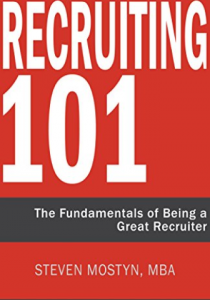
Steven Mostyn is a leading expert in recruitment and a regular contributor to major HR publications, like Recruiting Headlines, HR.com, and others. We’ve chosen his book, Recruiting 101 because it’s a great starting resource for newbies in recruitment and for other professionals who are interested in HR or have to deal with hiring.
Recruiting 101 is based on the fifteen fundamentals to become a great recruiter, which start from developing the right attitude and motivation, establishing your own recruitment brand and identity and finish with interviewing the right people and closing the desired positions. What we’ve also particularly liked about the book was how succinctly and concisely Mostyn described the procedures and techniques, without diluting the key concepts with unnecessary detail. He also begins with a very inspiring (short!) story of how he achieved his success as a famous recruiter by staying positive, setting up the right goals to achieve, and never giving up. Some of us badly need inspiration stories these days, right?
The structure and writing of the book reminded us of the sales manager’s success manuals that aim to teach you to sell anything, which is partly a great thing and what makes this book stand out from others: the narrative sets you up from the very beginning on a pathway toward becoming a successful recruiter.
Among useful advice, we’ve drawn out from the book, were:
— Creating a selling sheet of key features of your company that would be desirable for a prospective employee
— Knowing the positions you’re hiring for like ABC
— Creating captivating job titles and complete detailed descriptions starting with reasons why an applicant would want to work with you (like you’ll work a minute from the beach, great team building, and career growth opportunities, lifelong training, etc)
— Employing different advertising and marketing channels, from SEO to social media
— Creating awareness around you as a successful recruiter with an outstanding track record and particular techniques you employ
— Learning to work faster and more efficient
— Using paid resume databases, using various search techniques, like boolean
— Cold calling tips
— Best interviewing practices and other cool features and useful links for ‘never stop learning”
Recruiting 101 is a fantastic book with lots of tips and links to useful resources and how to use them. If you’re new to recruiting, this book is definitely worth checking out.
Conclusion
The books we’ve covered in this Book Review Special is a series of reviews of books we find particularly useful in our working practice so we decided to share them with a broader audience. We’ll also write a series on useful blogs and podcasts in the future. So stay tuned.
Also, if you think we’ve missed any recent book that’s worth mentioning or you loved any other particular book, please, share it in the comments and we’ll read and review it in later blog posts.



